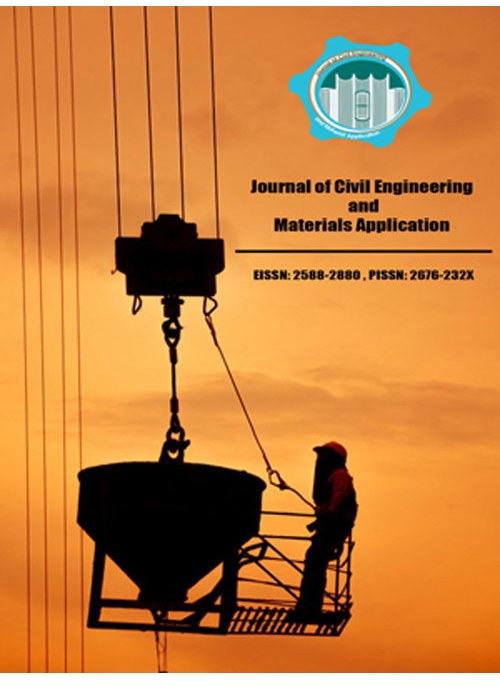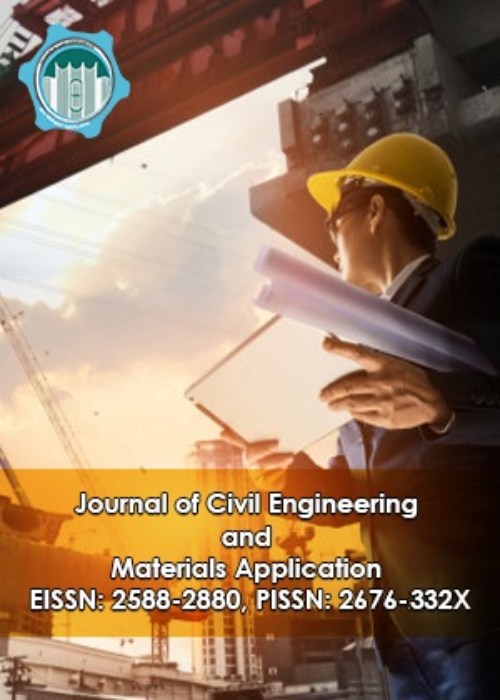فهرست مطالب

Journal of Civil Engineering and Materials Application
Volume:6 Issue: 3, Summer 2022
- تاریخ انتشار: 1401/06/10
- تعداد عناوین: 5
-
Pages 123-130
SMA asphalt mixtures are one of the asphalt mixtures known so far. In these mixtures, the load transfer and degradation process takes place through the direct contact of stone on stone. In these mixtures, like other asphalt mixtures, various additives are used with the aim of improving the performance characteristics. Common additives in these mixtures include anti-stripping additives, polymer, nano materials, etc. On the other hand, during the past years, a new technology in the production of additives is being developed. In this technology, with the chemical combination of two additives, a new substance is produced, which is referred to as a double additive and has the characteristics of both the main substances. In this research, this issue has been investigated in SMA asphalt mixtures and the effect of dual additive produced from rubber powder and recycled polyethylene (rPET) has been investigated. The results of this research showed that the use of double additives of this research can meet the performance characteristics of SMA asphalt mixtures better than single additives and the interaction of the two materials used can compensate for the weaknesses of single additives.
Keywords: dual base additive, recycled polyethylene, rubber powder, SMA asphalt mixture -
Pages 131-148
In this paper, statistical analysis of Acoustic Emission (AE) based b-value parameter has been carried out. In the initial phase, multi-linear regression was carried out on AE parameters released during uniaxial compression of twelve cylindrical samples. The study exhibited that Counts, RMS values and reciprocal of Absolute Energy are promising parameters to quantify the b-value. In the similar analysis, the AE behavior measured in terms of b-value was studied for standard cubes and cylinders. Firstly, the two-way ANOVA test was done on Counts, RMS values and reciprocal of Absolute Energy and a hypothesis was made that b-value measured in the said parameters would be same. The results support the hypothesis and prove statistically that three variables are same no matter whether they are taken from cubic specimens or from cylindrical specimens even though the cracking behavior of cubes and cylinders is different. The results are also verified by one-tailed F-test.
Keywords: multi-linear regression analysis, ANOVA test, F-test, Kolmogorov-Smirnov test, Lavene’ s test -
Pages 149-158
Concrete is the most widely used construction material owing to its good strength, mouldability and robustness. However, its durability has always been a cause of concern arising mainly due to the fact that concrete is highly porous, microcracked and hydrophilic in nature making water ingress into it unavoidable. Water ingress is the primary cause for all major durability related issues in concrete such as freezing and thawing, reinforcement corrosion, carbonation, efflorescence etc. It is thus evident that to prevent deterioration and thereby increase durability and service life of concrete structures, water ingress into it must be minimized. This can be accomplished by a number of methods out of which hydrophobic treatment of concrete is nowadays becoming popular. Surface Hydrophobic Treatment and Integral/Bulk Hydrophobic Treatment are two main ways to induce water repellency in concrete. In this work, the efficacy of integrally incorporating a silane product into concrete and providing a surface treatment using the same product on the mechanical, durability and physical properties has been studied. Integral modification did not yield satisfactory results in case of water proofing the composites with the Water Contact Angle values lying below 90˚ in the hydrophilic range. Whereas, the surface treatment reported a successful hydrophobic modification reporting Water Contact Angle value as high as 157.1˚. The Water Contact Angle values for all surface modified samples were over 150˚ which lies in the superhydrophobic category along with the composites exhibiting a self-cleaning behaviour with very little effect on the compressive and tensile strength.
Keywords: Hydrophobic, Porous, Silane, Durability, Concrete -
Pages 159-174
The use of low-grade calcined clays is the only potential material available in large quantities to meet the requirements of eco-efficient supplementary cementitious materials by decreasing the clinker content in blended types of cement or cement content in concrete. In the present paper, six mortar mixtures with a constant w/b ratio were used to investigate the mechanical and durability properties of mixtures substituted with low-grade calcined clays with/without limestone compared to PC and silica fume mixtures. The results obtained show that using calcined clays with low or intermediate purity (i.e., kaolinite content) leads to enhanced durability properties besides the comparable strength development characteristics compared to PC mortar. In this regard, the addition of 30% calcined clay with/without limestone led to a marked decrease (about 80 and 40%) in chloride ion diffusion coefficient (Da) and an increase in surface chloride content (Cs) compared to the reference mixture. In addition, the utilization of calcined clay with a kaolinite content of 56.7% led to a reduction of 52% in Da and an increase of 140% in electrical resistivity compared to silica fume binder. The primary reason for the better performance is attributed to the refined pore structure and dense microstructure of the cement paste with the calcined clay pozzolan compared to PC and silica fume.
Keywords: Calcined clay, durability, Kaolinite, Limestone, chloride diffusion -
Pages 175-183
Nowadays, due to the increase in the amount of traffic and the number of axles, the use of additives in asphalt concrete has become common. In recent decades, one of the goals of engineers in asphalt technology has been to increase the bearing capacity and improve the tensile strength of asphalt mixtures. One of these effective additives in this matter is fiber. Fibers mainly contribute to the reinforcement of asphalt mixtures. Accordingly, in this research, the properties of asphalt mixtures reinforced with 5-component fibers and glass fibers have been investigated. 5-component fibers areadded in 0.05, 0.075 and 0.01% of the weight of stone materials and glass fibers are added in 0.1, 0.2 and 0.3% of the weight of stone materials in asphalt mixtures and finally based on performance characteristics including Marshall resistance, indirect tension, moisture sensitivity, dynamic creep and resilient modulus are the most optimal among the above percentages. According to the results of this research, 5-component fibers have the best results in many of the mentioned characteristics at 0.075 percent and glass fibers at 0.2 percent.
Keywords: 5-component fibers, glass fibers, optimization, performance characteristics, asphalt mixture


